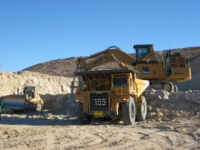Australian-based Paladin Energy has announced expansion plans for both its Langer Heinrich and Kayelekera uranium mines, but has revised its 2010 production forecasts downwards.
 |
| Langer Heinrich (Image: Paladin) |
Quarterly results just released by Paladin show the mine to be operating at 90% of its current nameplate capacity, and it should achieve its full 3.7 million lb (1423 tU) per year capacity by the end of 2009, says Paladin.
Although the ramp-up of production at the Kayelekera mine in Malawi is behind schedule, Paladin says that it is still on target to reach its nameplate capacity of 3.3 million lb (1270 tU) per year by March 2010. The company says it will also conduct an optimisation study to exploit additional resources by extending the current pit, with the target of increasing production to 3.8 million lbs (1462 tU) per year by 2012.
In total, the expansion plans would see Paladin's African projects producing approximately 13.8 million lb U3O8 (5308 tU) per year by mid-2014. Nevertheless, the company has revised its overall production projections for the 2010 financial year from 6.6 million lb U3O8 (2540 tU) down to 5.6-6.1 million lb (2154-2346 tU), citing slower than expected production ramp-ups.





_69614.jpg)

_15447.jpg)




